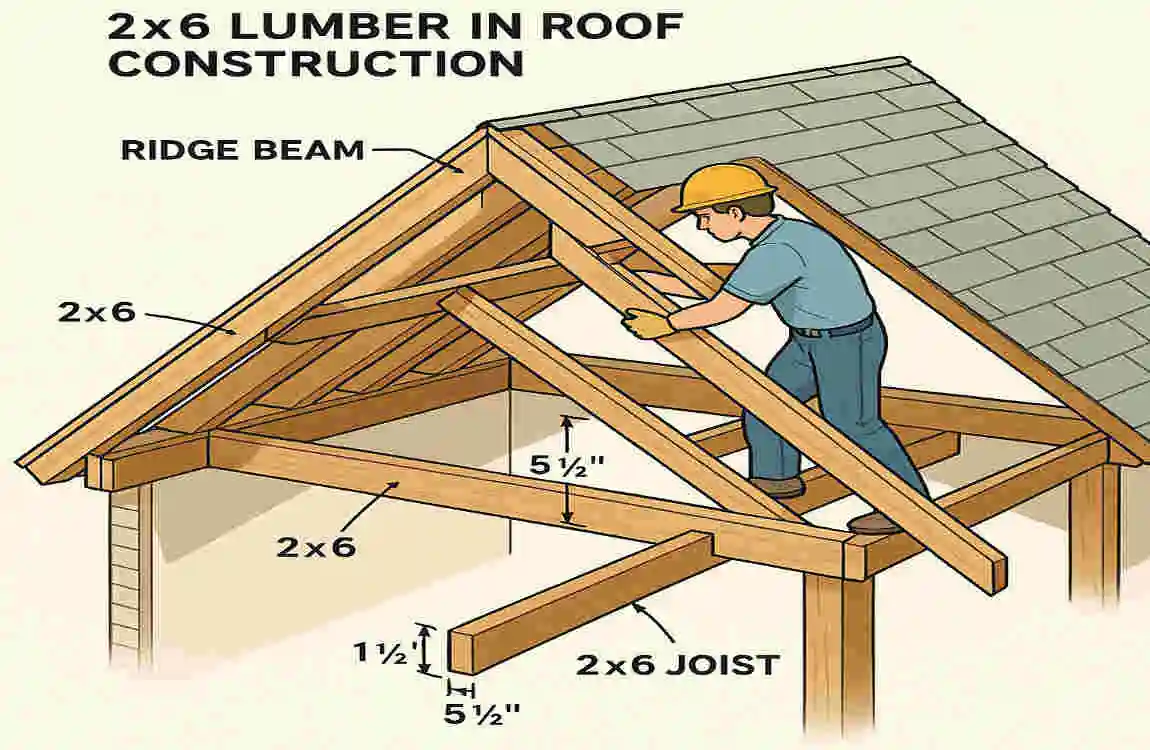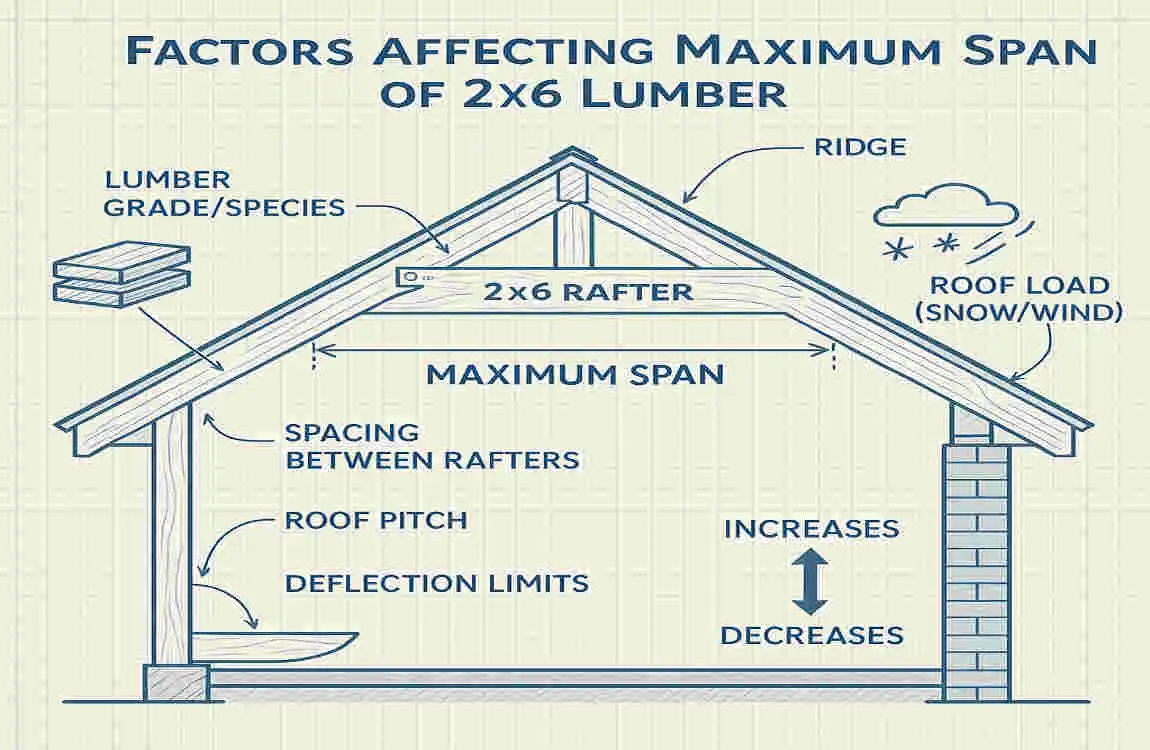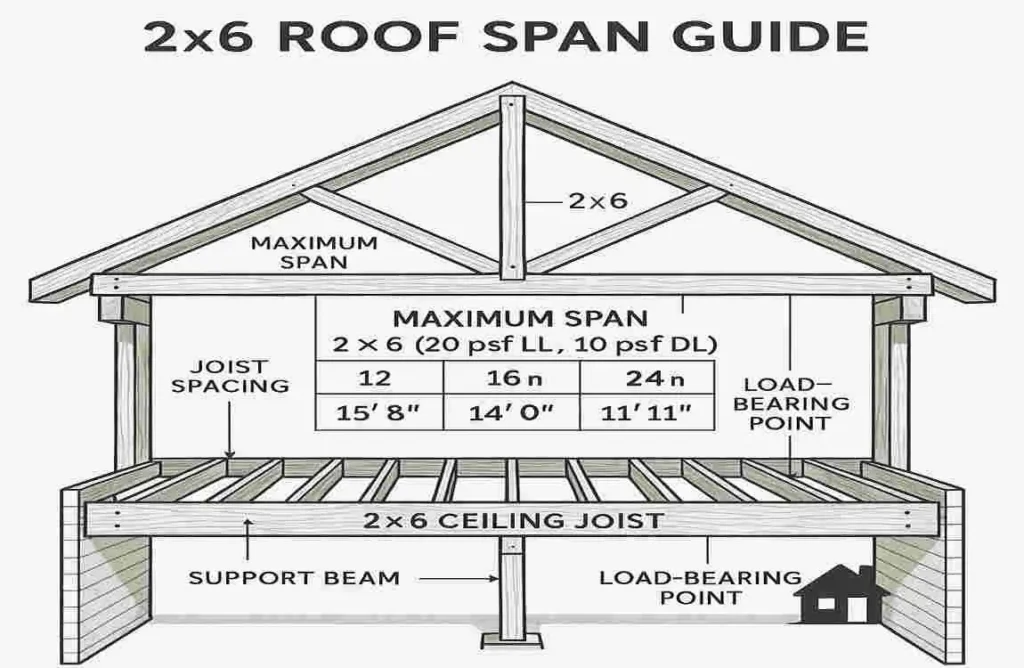When it comes to building a strong and durable home, proper roof framing is absolutely essential. The roof is what keeps your home safe and secure, protecting you and your family from the elements. So, it’s crucial to get it right. One common question that often comes up is: “How far can you span a 2×6 for a roof?”
Understanding 2×6 Lumber for Roof Construction

Before we dive into the specifics of 2×6 roof spans, let’s take a moment to understand what we’re working with. A 2×6 is a piece of dimensional lumber that measures 1.5 inches by 5.5 inches. It’s a common choice for residential roof framing due to its strength and versatility.
Dimensions and Uses
A 2×6 is typically used for roof rafters, which are the sloping members that support the roof decking. They can also be used for ceiling joists, wall studs, and other structural elements. The actual dimensions of a 2×6 may vary slightly depending on the manufacturer, but they should always be close to the nominal size.
Strength and Load-Bearing Capacity
One of the key advantages of using 2×6 lumber for roof framing is its strength. When properly installed and spaced, 2×6 rafters can handle a significant amount of weight. The exact load-bearing capacity will depend on factors such as the species of wood, grade, and moisture content; however, 2×6 lumber is generally considered strong enough for most residential applications.
Advantages of Using 2×6 Lumber
There are several reasons why 2×6 lumber is a popular choice for roof framing:
- Strength: As mentioned, 2×6 lumber is strong enough to handle the loads imposed by most residential roofs.
- Cost: 2×6 lumber is generally less expensive than larger sizes, such as 2×8 or 2×10.
- Availability: 2×6 lumber is widely available at most lumber yards and home improvement stores.
- Ease of Installation: 2×6 lumber is relatively easy to work with and install, making it a suitable choice for both DIYers and professionals.
Factors Affecting How Far You Can Span a 2×6 for a Roof
Now that we have a basic understanding of 2×6 lumber, let’s explore the factors that affect how far you can span it for a roof. There are several key considerations to keep in mind:
Load Types
The loads that a roof must support can be divided into several categories:
- Live Load: This is the weight of people, furniture, and other objects that may be on the roof.
- Dead Load: This is the weight of the roof itself, including the rafters, decking, and roofing materials.
- Snow Load: In areas that experience heavy snowfall, the weight of the snow on the roof must be taken into account.
- Wind Load: Wind can exert significant forces on a roof, especially in areas prone to high winds or hurricanes.
The total load that a roof must support is the sum of these individual loads, and it will affect the maximum span of the 2×6 rafters.
Lumber Species and Grade
The species and grade of the lumber used for the rafters will also impact the maximum span. Different species of wood have varying strengths, and the grade of the lumber affects its load-bearing capacity. For example, a 2×6 made from Douglas Fir will have a different span capacity than one made from Southern Pine.
Roof Pitch
The pitch of the roof, or the angle at which it slopes, will also affect the maximum span of the 2×6 rafters. A steeper roof pitch will distribute the loads more evenly across the rafters, allowing for a longer span. A flatter roof pitch, on the other hand, will put more stress on the rafters and may require a shorter span.
Rafter Spacing
The spacing between the rafters, measured from the center of one rafter to the center of the next, will also impact the maximum span. The most common spacings are 16 inches on center and 24 inches on center. A closer spacing will allow for a longer span, while a wider spacing may require a shorter span.
Environmental Considerations
Finally, the location and climate of the building site will also affect the maximum span of the 2×6 rafters. Areas with heavy snowfall or high winds may require shorter spans to ensure the roof can withstand the loads. The moisture content of the lumber can also impact its strength and span capacity.
Span Tables and Codes for 2×6 Roof Rafters
To determine the maximum span of a 2×6 rafter, house builders and homeowners can refer to span tables and building codes. These resources provide guidance on the appropriate span lengths based on the factors we discussed earlier.
Understanding Span Tables
A span table is a chart that displays the maximum span lengths for various lumber sizes and species, based on specific load conditions and spacing. The table will typically have columns for the species and grade of the lumber, the load conditions (e.g., live load, dead load, and snow load), and the spacing between the rafters.
To use a span table, you’ll need to know the specific conditions of your project, such as the species and grade of the lumber, the load conditions, and the desired spacing. Once you have this information, you can find the corresponding maximum span length in the table.
Typical Span Limits for 2×6 Rafters
The exact span limits for 2×6 rafters will depend on the specific conditions of your project, but here are some general guidelines:
- For a roof with a 4:12 pitch, 2×6 rafters spaced 16 inches on center can typically span up to 10 feet for a live load of 20 psf and a dead load of 10 psf.
- For a roof with a 6:12 pitch, 2×6 rafters spaced 24 inches on center can typically span up to 12 feet for a live load of 20 psf and a dead load of 10 psf.
Please note that these are general guidelines, and the actual span limits for your project may vary depending on the specific conditions.
Building Codes and Standards
In addition to span tables, builders and homeowners must also follow the relevant building codes and standards for their area. These codes and standards will provide guidance on the minimum requirements for roof framing, including the maximum span lengths for different sizes and species of lumber.
Some common building codes and standards that may apply to roof framing include:
- International Residential Code (IRC)
- International Building Code (IBC)
- American Society for Testing and Materials (ASTM) standards
It’s essential to consult with a local building official or a licensed professional to ensure that your roof framing complies with the relevant codes and standards for your area.
Example Span Table Segment
Here’s an example segment of a span table for 2×6 rafters, based on the 2018 International Residential Code:
Species Grade Live Load (psf) Dead Load (psf) Spacing (in)Maximum Span (ft-in)
Douglas Fir-Larch No. 2 20 10 16 10-0
Douglas Fir-Larch No. 2 20 10 24 8-8
Southern Pine No. 2 20 10 16 10-6
Southern Pine No. 2 20 10 24 9-0
This table shows the maximum span lengths for 2×6 rafters made from Douglas Fir-Larch and Southern Pine, based on a live load of 20 psf, a dead load of 10 psf, and spacings of 16 inches and 24 inches on center.
How Far Can You Span a 2×6 for a Roof? Practical Guidelines

Now that we’ve covered the factors that affect the maximum span of a 2×6 rafter and the relevant span tables and codes, let’s dive into some practical guidelines for determining the appropriate span length for your project.
Detailed Span Limits Summary
Based on the span tables and codes we discussed earlier, here are some general guidelines for the maximum span lengths of 2×6 rafters:
- For a roof with a 4:12 pitch, 2×6 rafters spaced 16 inches on center can typically span up to 9 to 10 feet, depending on the species and grade of the lumber, as well as the load conditions.
- For a roof with a 6:12 pitch, 2×6 rafters spaced 24 inches on center can typically span up to 11 to 12 feet, depending on the species and grade of the lumber, as well as the load conditions.
Please note that these are general guidelines, and the actual span limits for your project may vary depending on the specific conditions.
Recommended Spacing
The spacing between the rafters will also impact the maximum span length. A closer spacing will allow for a longer span, while a wider spacing may require a shorter span.
For most residential applications, 2×6 rafters are typically spaced either 16 inches on center or 24 inches on center. A 16-inch spacing is generally considered to be stronger and more stable, but it may also be more expensive due to the additional lumber required. A 24-inch spacing is less costly, but it may require shorter span lengths to ensure the roof remains stable.
Choosing 2×6 vs. Larger Lumber
In some cases, you may need to decide whether to use 2×6 lumber or a larger size, such as 2×8 or 2×10. This decision will depend on several factors, including the load conditions, the desired span length, and the project’s budget.
In general, 2×6 lumber is suitable for most residential applications with moderate load conditions and span lengths. However, if you need to span a longer distance or handle heavier loads, consider using a larger size, such as 2×8 or 2×10.
Real-World Examples or Case Studies
To help illustrate these concepts, let’s look at a couple of real-world examples or case studies:
- Shed Roof: For a small shed with a simple roof design, 2×6 rafters spaced 24 inches on center may be sufficient to span up to 10 feet, depending on the load conditions and the species and grade of the lumber.
- Residential Home: For a larger residential home with a more complex roof design, 2×6 rafters spaced 16 inches on center may be needed to span up to 12 feet, depending on the load conditions and the species and grade of the lumber.
These are just a couple of examples, and the actual span limits and lumber requirements will vary based on the specific conditions of each project.
Construction Tips for Strong Roof Framing with 2×6 Lumber
Now that we’ve covered the basics of 2×6 roof spans, let’s explore some practical tips for constructing a robust and durable roof using 2×6 lumber.
Proper Installation Techniques
Proper installation is key to ensuring the strength and stability of your roof. Here are some tips to keep in mind:
- Use the proper fasteners: Ensure you use the correct nails or screws for the job and follow the manufacturer’s recommendations for spacing and placement.
- Secure the rafters to the ridge board: The ridge board is the horizontal member at the peak of the roof, and it’s essential to securely fasten the rafters to it to ensure the stability of the roof.
- Install collar ties or rafter ties: Collar ties or rafter ties are horizontal members that connect the rafters and help to prevent them from spreading apart under load. Ensure that you install them at the proper height and spacing to maintain the roof’s stability.
Importance of Bracing, Blocking, and Supports
In addition to proper installation, bracing, blocking, and supports are also crucial for ensuring the strength and stability of your roof. Here are some tips to keep in mind:
- Install bracing at the gable ends: The gable ends of the roof are particularly vulnerable to wind and other forces, so it’s essential to install bracing to help support them.
- Use blocking between the rafters: Blocking is short pieces of lumber installed between the rafters to help prevent them from twisting or warping under load. Ensure that you install blocking at the proper spacing to maintain the roof’s stability.
- Add supports as needed: Depending on the span length and load conditions, you may need to add additional supports, like posts or beams, to help support the rafters. Ensure you consult with a professional to determine the most suitable support system for your project.
Choosing the Right Fasteners and Connectors
The proper fasteners and connectors are essential for ensuring the strength and stability of your roof. Here are some tips to keep in mind:
- Use the correct type of fastener: Ensure you use the proper kind of nail or screw for the job and follow the manufacturer’s recommendations for size and spacing.
- Use the correct type of connector: There are many different types of connectors available for roof framing, including hurricane ties, rafter ties, and ridge connectors. Ensure you use the correct type of connector for your project and follow the manufacturer’s installation recommendations.
- Use the right size and spacing: Ensure you use the correct size and spacing for the fasteners and connectors, and follow the manufacturer’s recommendations to maintain the strength and stability of your roof.
Impact of Roofing Materials on Load and Span Requirements
The type of roofing material you choose can also impact the load and span requirements for your roof. Here are some tips to keep in mind:
- Consider the weight of the roofing material: Different roofing materials have varying weights, which can impact the load and span requirements for your roof. Ensure that you factor in the weight of the roofing material when determining the appropriate span length and spacing for your rafters.
- Consider the wind resistance of the roofing material: Some roofing materials are more resistant to wind than others, and this can impact the load and span requirements for your roof. Ensure that you select a roofing material suitable for your local wind conditions.
- Consider the installation requirements of the roofing material: Some roofing materials have specific installation requirements that can impact the load and span requirements for your roof. Ensure you follow the manufacturer’s installation recommendations to maintain the strength and stability of your roof.
Common Questions and Misconceptions About 2×6 Roof Spans
Now that we’ve covered the basics of 2×6 roof spans and construction tips, let’s address some common questions and misconceptions about this topic.
Is 2×6 Strong Enough for Modern Roofing Needs?
One common question is whether 2×6 lumber is strong enough for modern roofing needs. The answer is that it depends on the specific conditions of your project.
In general, 2×6 lumber is strong enough for most residential applications with moderate load conditions and span lengths. However, if you need to span a longer distance or handle heavier loads, consider using a larger size, such as 2×8 or 2×10.
It’s essential to consult with a professional to determine the appropriate size and spacing of the rafters for your specific project.
How to Handle Heavy Snow or Wind Zones Using 2×6 Lumber
Another common question is how to handle heavy snow or wind zones using 2×6 roof lumber. The answer is that it depends on the specific conditions of your project.
In areas with heavy snowfall or high winds, you may need to take extra precautions to ensure the roof’s strength and stability. This could include:
- Using a closer spacing for the rafters: A closer spacing will help to distribute the loads more evenly across the rafters, making the roof more resistant to heavy snow or wind.
- Adding additional supports: Depending on the span length and load conditions, you may need to add extra supports, like posts or beams, to help support the rafters.
- Choosing a stronger species or grade of lumber: Some species and grades of lumber are stronger than others, and this can impact the maximum span length and load capacity of your roof. Ensure that you select a species and grade suitable for your local conditions.
It’s essential to consult with a professional to determine the appropriate measures for handling heavy snow or wind zones in your area.
Can 2×6 Be Spaced at 24-Inch Centers?
Another common question is whether 2×6 rafters can be spaced at 24-inch centers. The answer is that it depends on the specific conditions of your project.
In general, 2×6 rafters can be spaced at 24-inch centers for most residential applications with moderate load conditions and span lengths. However, if you need to span a longer distance or handle heavier loads, consider using a closer spacing, such as 16 inches on center.
It’s essential to consult with a professional to determine the appropriate spacing for the rafters in your specific project.
Alternatives if Longer Spans Are Required
If you need to span a longer distance than what is possible with 2×6 lumber, there are several alternatives you can consider:
- Use a larger size of lumber: Larger sizes like 2×8 or 2×10 can span longer distances than 2×6 lumber, but they may also be more expensive.
- Add additional supports: Depending on the span length and load conditions, you may be able to add extra supports, like posts or beams, to help support the rafters and allow for a longer span.
- Use engineered wood products: Engineered wood products like laminated veneer lumber (LVL) or parallel strand lumber (PSL) can span longer distances than traditional lumber, but they may also be more expensive.
It’s essential to consult with a professional to determine the best alternative for your specific project.
Benefits of Using 2×6 Lumber in Roofing Beyond Spanning
In addition to its spanning capabilities, 2×6 lumber also offers several other benefits for roofing applications:
Energy Efficiency and Insulation Advantages
One of the key benefits of using 2×6 lumber for roof framing is its energy efficiency and insulation advantages. The deeper cavity of a 2×6 rafter allows for more insulation to be installed, which can help to reduce heat loss and improve the energy efficiency of your home.
In addition, the wider spacing between the rafters can also help to reduce thermal bridging, which is when heat is transferred through the framing members and reduces the effectiveness of the insulation.
